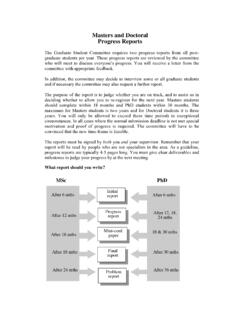Transcription of Writing Thesis and Dissertation Proposals
1 Writing a Thesis or Dissertation proposal 1. Writing Thesis and Dissertation Proposals The graduate Writing Center of the Center for Excellence in Writing Overview: This workshop will introduce basic principles of Writing Proposals across a range of disciplines. It will present practical strategies, and it will include examples of successful Proposals . Goals 1. To introduce strategies for bridging the gap between coursework/beginning research and Thesis Writing . 2. To help you understand the rhetorical situation of the Thesis proposal and common elements of such Proposals . 3. To introduce practical rhetorical and grammatical principles of Writing effective Proposals . 4. To provide you with tips for drafting and revising individual sections of the proposal . About this Workshop and the graduate Writing Center: Please note that these workshops are designed to address general Writing principles. As a result, you may not find information in this packet or during the workshop that is directly relevant to your field or your current study.
2 The best way to view these workshops is as opportunities to be exposed to general skills that should transfer across disciplines. That means attending these workshops is not a substitute for reading extensively in your field or for asking questions of advisors or peers. The graduate Writing Center, located in 111-L Kern Building, provides free, one-on-one consultations for graduate students working on any kind of Writing project from seminar papers and presentations to articles and dissertations. Scheduling an appointment with the graduate Writing Center is an excellent way to follow up on the practical information you receive during the workshops. To learn more about the graduate Writing Center, visit the Center's website at You may also schedule appointments directly, at Please try to schedule an appointment as far in advance of due dates as possible. To cancel an appointment, call Writing a Thesis or Dissertation proposal 2. Writing Thesis / Dissertation Proposals Your Thesis / Dissertation proposal provides an overview of your proposed plan of work, including the general scope of your project, your basic research questions, research methodology, and the overall significance of your study.
3 In short, your proposal explains what you want to study, how you will study this topic, why this topic needs to be studied, and (generally) when you intend to do this work. (Occasionally, you may also need to explain where your study will take place.). Purpose: Dissertation / Thesis Proposals are designed to: Justify and plan (or contract for) a research project. Show how your project contributes to existing research. Demonstrate to your advisor and committee that you understand how to conduct discipline-specific research within an acceptable time-frame. Audience: Most Proposals are written specifically for your academic advisor and committee. proposal Writing and Anxiety General Advice: Establish a Writing schedule, preferably Writing at the same time and place each day. Begin by free- Writing . Remember that no one but you has to see the initial draft. Keep a small notebook with you throughout the day to write down relevant thoughts. Say parts of your Writing into a recording device and then play it back to yourself.
4 Compose different parts of the proposal in different computer files or on different index cards to help with arranging and rearranging. Start with more clear cut sections first, rather than with the Introduction, since it may be the most difficult part to write. proposal -Specific Advice: Understand that the proposal will be a negotiated document, so be prepared to draft, redraft, and resubmit it. Think of the proposal as an introduction to your Thesis not a chapter, not an extensive literature review, not an opportunity to rehearse the major conflicts in your field. You are bridging the gap between existing work and your work. Remember that the proposal is not a contract that determines what your Thesis will demonstrate. You will likely modify and refine your scope, argument, and methods. Remember that your proposal is not meant to limit your ideas, but to help you think in practical terms about how you intend to research and write your Dissertation . Ask colleagues to form a Writing group that you can use to exchange ideas, drafts, and experiences.
5 As lonely as it may seem sometimes, Writing is a social activity. Because proposal requirements vary broadly by department, program, and advisor, generalizing them is difficult. The best advice is the simplest: consult with your advisor, ask to see past successful Proposals , and talk to your colleagues. Using other Proposals to help you generate ideas in not plagiarizing! Writing a Thesis or Dissertation proposal 3. PARTS OF A proposal . Despite their wide differences, Proposals across programs generally include at least some form of the following sections (though you will want to check with your academic advisor about the specific sections s/he requires): Title, Abstract, Introduction/Background, Problem Statement, Purpose/Aims/Rationale, Review of Literature, Methodology, Significance/Implications, Overview of Chapters, Plan of Work, Bibliography. Sometimes these sections may be combined in some fields, the problem statement, aims, and review of literature are all part of the introduction.
6 The most common elements are the introduction/problem statement, review of literature, and methodology (which in some fields roughly correspond to the first three chapters of the Dissertation ). Title At this early stage, you need only provide a working title. You can decide on the exact wording for your title when you are nearer to completing your Dissertation . Nevertheless, even at the start, aim to create a title that conveys the idea of your investigation. Normally, a title beginning A study in .. is too vague; decide whether you want to compare, collate, assess, etc. Also, don't worry if you compose a long title. You are preparing to write an academic document, not to devise a snappy headline for a tabloid newspaper. A good title should: Orient your readers to the topic you will research. Indicate the type of study you will conduct. Examples: What do the following examples tell you about the topic and type of research conducted? Role of the Hydrologic Cycle in Vegetation Response to Climate Change: An Analysis Using VEMAP Phase 2 Model Experiments Geographic Representations of the Planet Mars, 1867-1907.
7 Abstract Not all fields require abstracts, so check with your advisor to see if you are required to include one. The abstract should: Provide a brief (100-350 word) overview of the proposal that gives a reader a basic understanding of your proposal and encourages her or him to read more. Summarize Introduction, Statement of the Problem, Background of the Study, Research Questions or Hypotheses, and Methods and Procedures. (In some cases, the abstract may need to be very brief no more than 50 words in which case, it will be more descriptive than complete.). Informative abstract: The Black-Bellied Plover (Pluvialis squatarola) is a shorebird species threatened with becoming endangered because of the loss of habitat through twentieth-century urbanization. As a step toward preventing this species from becoming endangered, this report identifies the Black-Bellied Plover habitat in Louisiana. To identify the habitat, I examined information about Black-Bellied Plover Writing a Thesis or Dissertation proposal 4.
8 Sightings in Louisiana over the last 50 years and the landuse categories derived from satellite imagery of the sighting locations. These examinations indicate that the Black-Bellied Plover habitat in Louisiana is generally pasture and shrubland. To protect this species, the Louisiana Department of Parks and Wildlife or the private sector should conserve and monitor this habitat, especially in the areas where the most frequent sightings have occurred on Grand Isle and around Caillou Bay. Descriptive abstract: The Black-Bellied Plover (Pluvialis squatarola) is a shorebird species threatened with becoming endangered because of the loss of habitat through twentieth-century urbanization. This report identifies the Black-Bellied Plover habitat in Louisiana based on previous sightings over the last 50. years and on landuse categories derived from satellite imagery of some of these sighting locations. The report also recommends conservation techniques to protect this species. Introduction/Background The introduction helps put your project in conversation with other projects on similar topics.
9 Generally, the introduction provides necessary background information to your study and provides readers with some sense of your overall research interest. A good introduction should: Establish the general territory (real world or research) in which the research is placed. Describe the broad foundations of your study, including some references to existing literature and/or empirically observable situations. In other words, the introduction needs to provide sufficient background for readers to understand where your study is coming from. Indicate the general scope of your project, but do not go into so much detail that later sections (purpose/literature review) become irrelevant. Provide an overview of the sections that will appear in your proposal (optional). Engage the readers. Example: How does this introduction to an environmental geography proposal introduce the topic? Although they did not know of the germs the animals might carry, residents of US cities in the 1860s and 70s cited the flies, roaches, and rats who swarmed the tenements in arguing for community sanitary programs.
10 In the 1950s vermin provided justification for housing and health agencies to pursue urban renewal, and also gave tenant activists a striking symbol of officials' neglect of their neighborhoods. Today, though we know that vermin produce indoor allergens, and we have pesticides designed to keep vermin at bay, the fact that both may be hazardous confuses parents, health officials, and other advocates who seek to protect health. As long as people have lived in cities, pest animals have joined us in our homes and buildings, affected our health, and propelled our policies on the urban environment. The social geography of pests, however, reflects the social position and physical surroundings of our neighborhoods. The researcher's objective is to use the ecological history and social geography of pest animals, which have been blamed for several kinds of disease exposures throughout the past two centuries, to investigate how health and environmental conditions are connected with poverty in cities.







